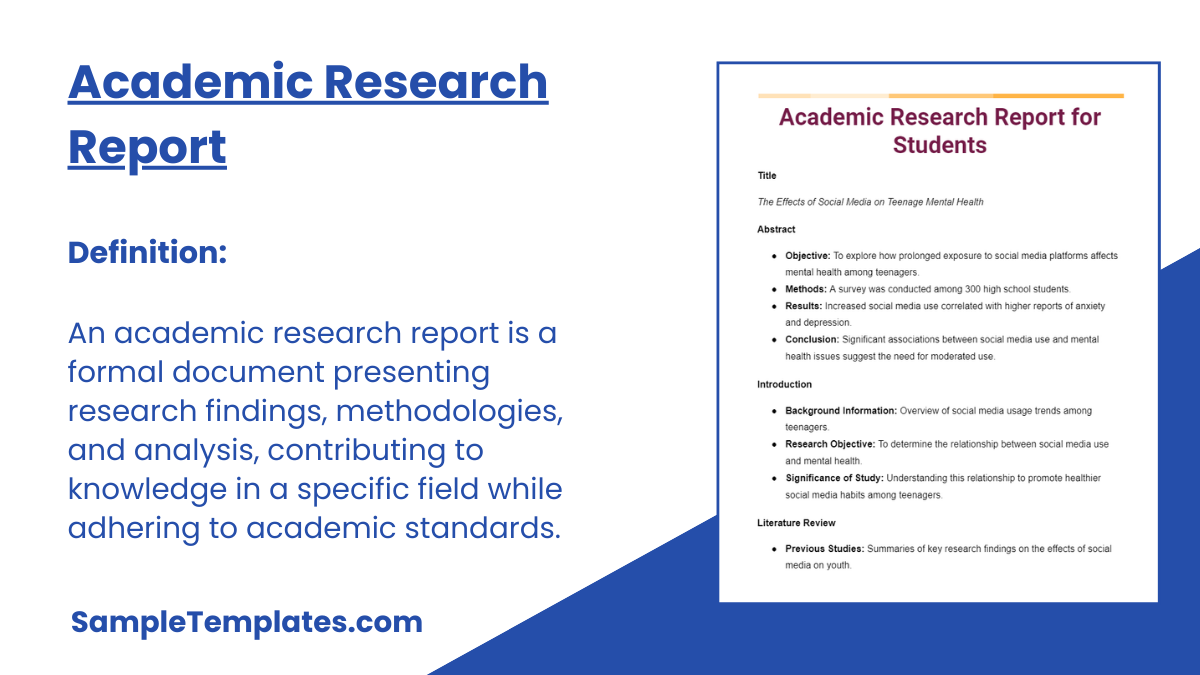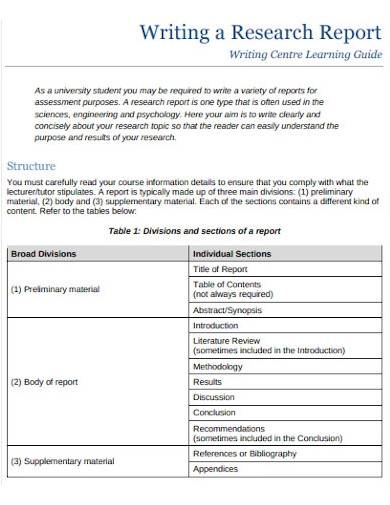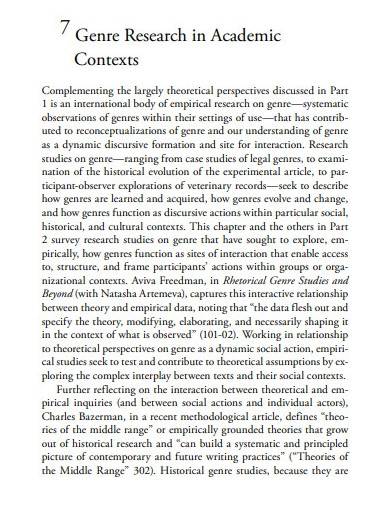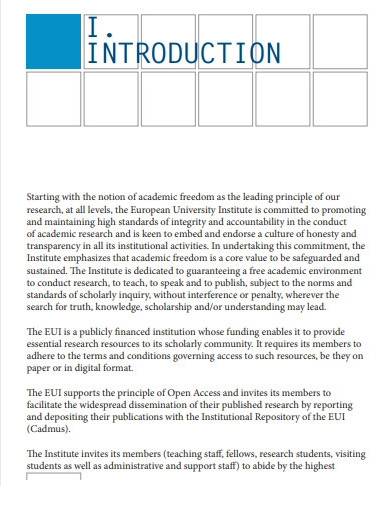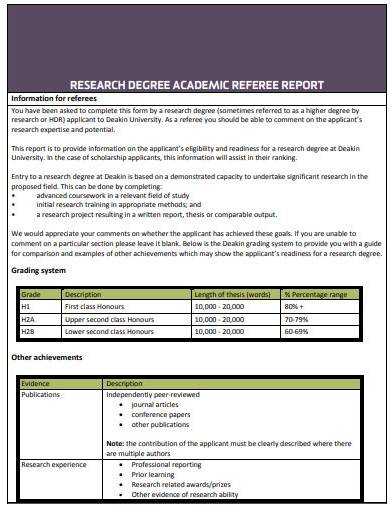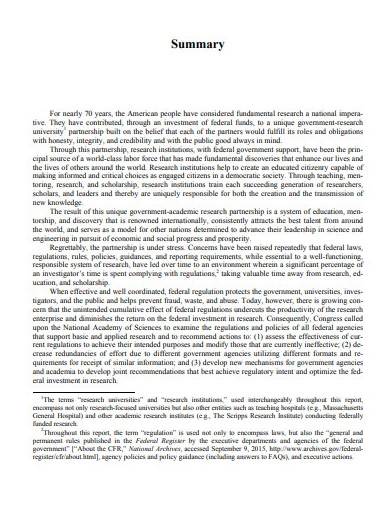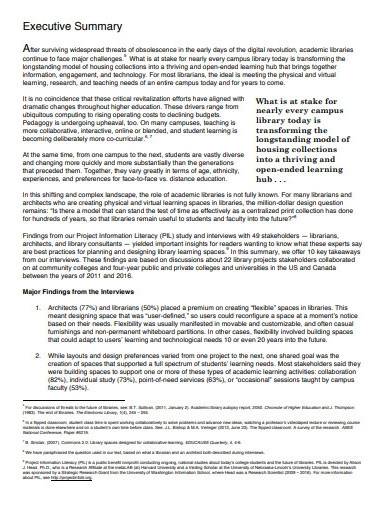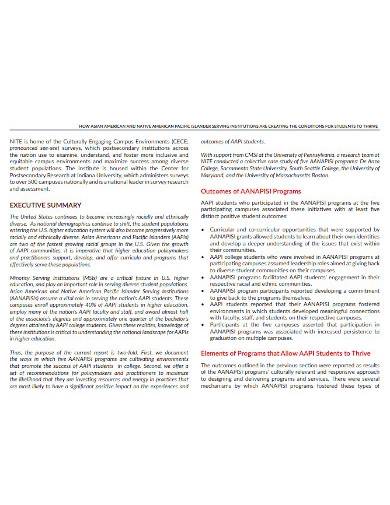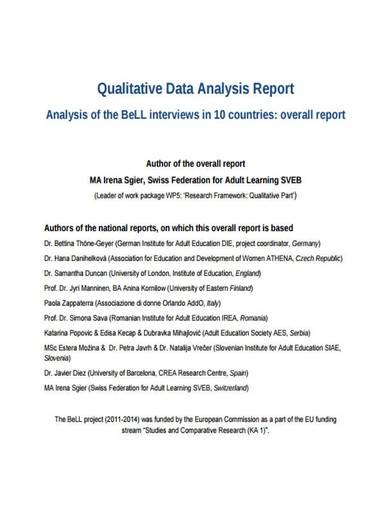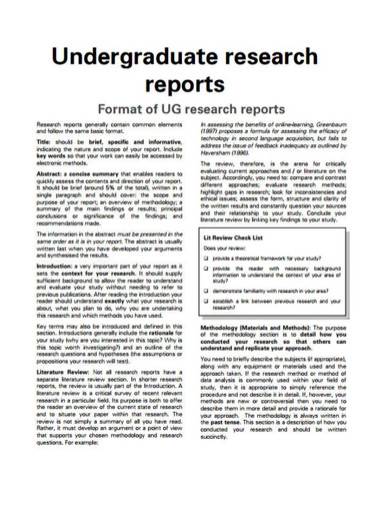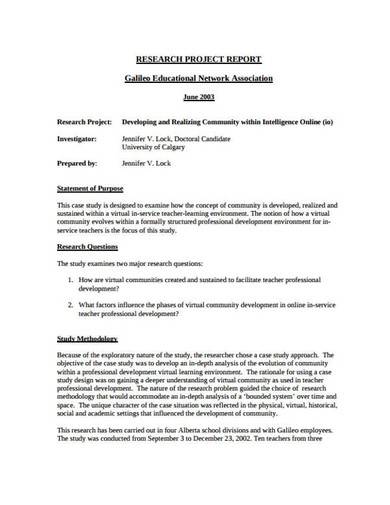What is a report? A report is a document or a written presentation that provides an organized format that is designed for a specific group of audience and purpose. Reports are used in different institutions, and they come in different formats. Among the many reports that we know is an academic research report. Academic reports play an important role in the discovery and introduction of new topics. Through academic research reports, many researchers find answers to difficult problems or questions. Let’s know more about academic research reports and how they’re made.
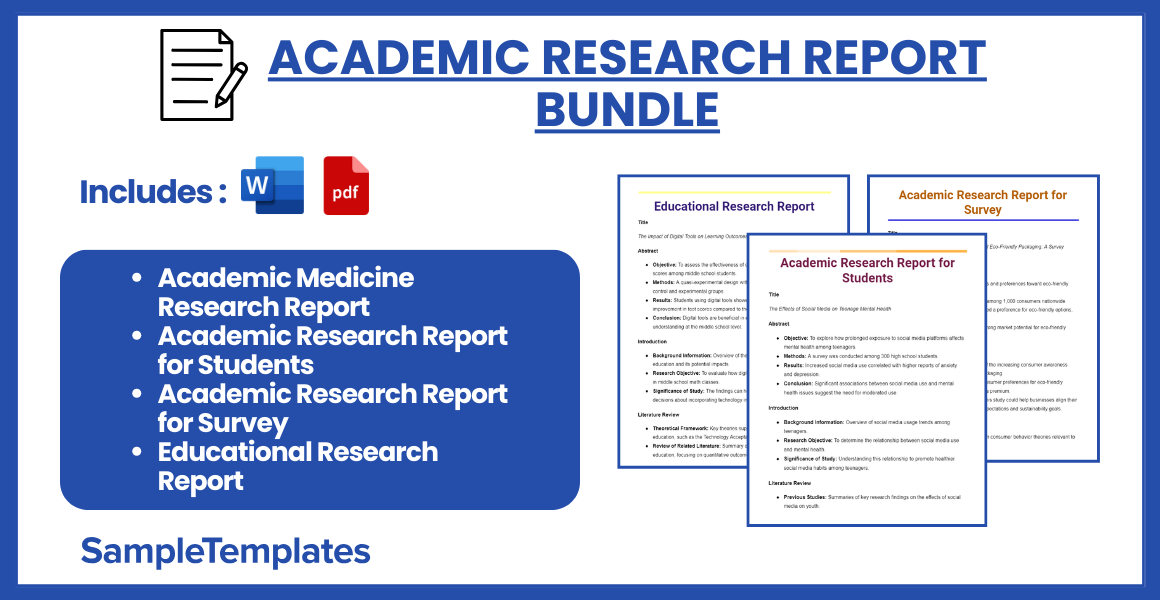
Download Academic Research Report Bundle
Academic Medicine Research Report
Title
Impact of Telemedicine on Chronic Disease Management: A Five-Year Study
Abstract
- Objective: To evaluate the effectiveness of telemedicine interventions in managing Type II Diabetes among rural populations over a five-year period.
- Methods: A longitudinal study was conducted with a cohort of 500 patients, utilizing a control group and an intervention group.
- Results: Telemedicine intervention showed a 30% improvement in managing blood sugar levels compared to the control.
- Conclusion: Telemedicine is an effective tool for chronic disease management in rural settings.
Introduction
- Background Information: Explanation of chronic disease management challenges in rural areas.
- Research Objective: To determine the impact of telemedicine solutions on the management of Type II Diabetes.
- Significance of Study: Importance of telemedicine in improving healthcare accessibility and outcomes.
Literature Review
- Previous Studies: Summary of previous research on telemedicine and chronic disease management.
- Gaps in Research: Identification of what previous studies have not addressed and how this study contributes to the existing knowledge.
Methods
- Study Design: Description of the longitudinal study design and rationale.
- Participants: Criteria for participant selection and description of participants (age, sex, health status).
- Intervention: Detailed description of the telemedicine interventions implemented.
- Data Collection Methods: Techniques used for data collection (surveys, medical records, interviews).
- Statistical Analysis: Explanation of statistical methods used to analyze the data.
Results
- Data Presentation: Presentation of data in tables and graphs.
- Statistical Findings: Summary of statistical analyses, including confidence intervals and significance levels.
- Subgroup Analyses: Results of any subgroup analyses conducted.
Discussion
- Interpretation of Results: Discussion on how the findings relate to previous studies.
- Implications: Broader implications of the findings for clinical practice and policy.
- Limitations: Discussion of the limitations of the study and their impact on the results.
- Future Research: Suggestions for future research topics based on the findings.
Conclusion
- Summary of Findings: Recap of the major findings and their importance.
- Clinical and Policy Implications: How the findings can be applied in practice or influence policy.
References
- Citation Style: Properly formatted references following a specific citation style (e.g., APA, MLA).
Appendices
- Additional Data: Any supplementary data, charts, or detailed methods that are relevant to the study.
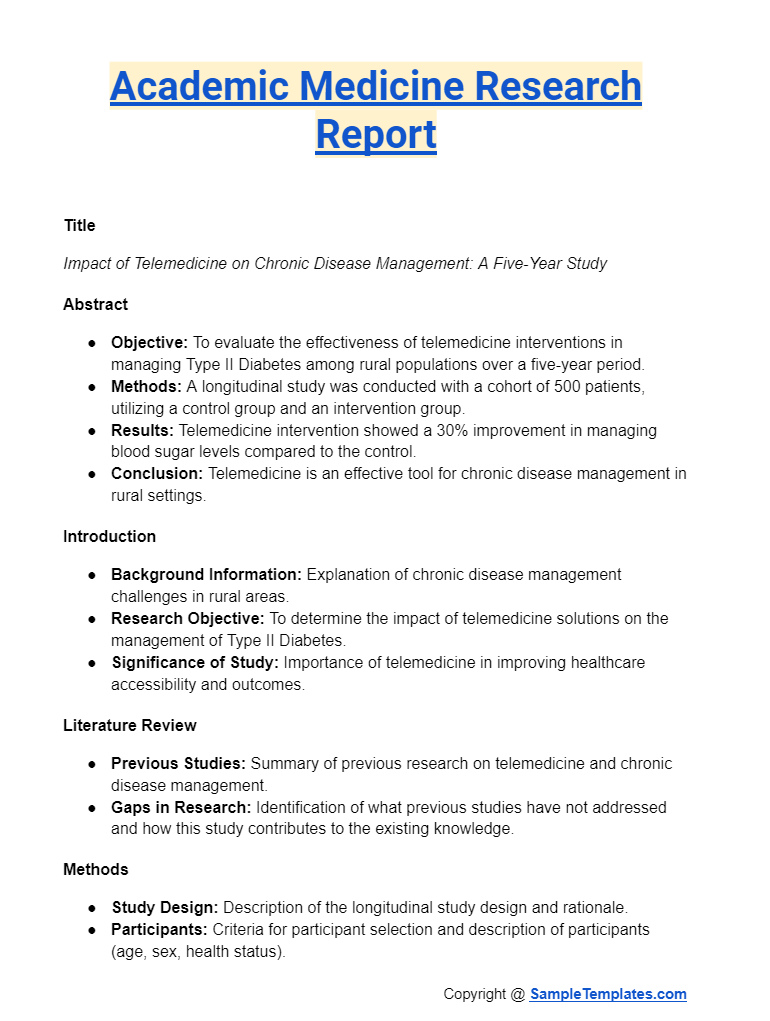
Academic Research Report for Students
Title
The Effects of Social Media on Teenage Mental Health
Abstract
- Objective: To explore how prolonged exposure to social media platforms affects mental health among teenagers.
- Methods: A survey was conducted among 300 high school students.
- Results: Increased social media use correlated with higher reports of anxiety and depression.
- Conclusion: Significant associations between social media use and mental health issues suggest the need for moderated use.
Introduction
- Background Information: Overview of social media usage trends among teenagers.
- Research Objective: To determine the relationship between social media use and mental health.
- Significance of Study: Understanding this relationship to promote healthier social media habits among teenagers.
Literature Review
- Previous Studies: Summaries of key research findings on the effects of social media on youth.
- Gaps in Research: What previous research has missed and how this report attempts to fill those gaps.
Methods
- Study Design: Description of the survey methodology and why it was chosen.
- Participants: Demographics of the survey participants (age, gender, social media usage patterns).
- Data Collection Methods: Tools and techniques used to gather data (e.g., questionnaires, interviews).
- Statistical Analysis: Overview of how data was analyzed to produce results.
Results
- Data Presentation: Charts, graphs, and tables displaying key data points.
- Findings: Description of major findings from the data analysis, such as the correlation coefficients and significance tests.
- Discussion Points: Preliminary interpretation of the results.
Discussion
- Interpretation of Results: In-depth discussion on what the findings mean in the context of existing research.
- Implications: How these findings affect the understanding of social media’s impact on mental health.
- Limitations: Limitations of the study that could affect the results, such as sample size or survey design.
- Recommendations for Future Research: Suggestions for further studies to explore unresolved questions.
Conclusion
- Summary of Findings: Recap of the most important findings and their implications.
- Call to Action: Suggested actions for stakeholders, such as educators and parents, to mitigate negative impacts.
References
- Formatted List: All sources cited in the research, formatted according to academic standards (APA, MLA, etc.).
Appendices
- Supplementary Materials: Any additional information such as full survey questions, informed consent forms, and raw data.
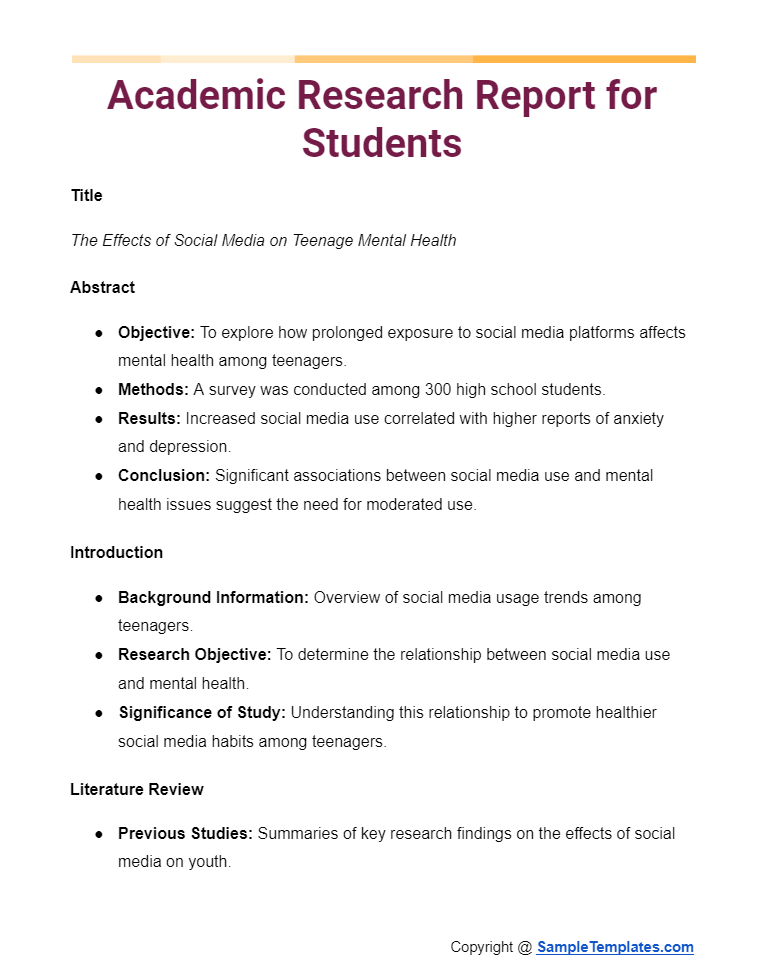
Academic Research Report for Survey
Title
Understanding Consumer Preferences Toward Eco-Friendly Packaging: A Survey Analysis
Abstract
- Objective: Examine consumer attitudes and preferences toward eco-friendly packaging solutions.
- Methods: An online survey distributed among 1,000 consumers nationwide.
- Results: A significant majority expressed a preference for eco-friendly options, citing environmental concerns.
- Conclusion: The findings suggest a strong market potential for eco-friendly packaging materials.
Introduction
- Background Information: Overview of the increasing consumer awareness regarding environmental impacts of packaging.
- Research Objective: To determine consumer preferences for eco-friendly packaging and their willingness to pay a premium.
- Significance of Study: Insights from this study could help businesses align their packaging strategies with consumer expectations and sustainability goals.
Literature Review
- Theoretical Framework: Discussion on consumer behavior theories relevant to environmental consciousness.
- Previous Research: Summary of existing studies on eco-friendly products and consumer choices.
- Research Gap: Identification of what previous studies have not covered, motivating the current research.
Methods
- Study Design: Justification for using a survey method.
- Sampling Method: Explanation of how participants were selected (random sampling, stratified, etc.).
- Survey Instrument: Description of the survey tool (e.g., Likert scales, multiple-choice questions, open-ended questions).
- Data Collection Procedure: How and when the survey was conducted.
- Data Analysis Techniques: Statistical tools and methods used to analyze the survey data (e.g., regression analysis, factor analysis).
Results
- Response Rate: Number of participants who completed the survey.
- Demographic Breakdown: Key characteristics of the survey population (age, gender, geographical distribution).
- Main Findings: Detailed presentation of survey results with supporting statistics and charts.
- Subgroup Analyses: Results segmented by different demographic groups, if applicable.
Discussion
- Interpretation of Results: Deep dive into what the survey findings mean in the context of existing literature and theories.
- Implications: Practical implications for businesses, policymakers, and other stakeholders.
- Limitations: Critique of the survey methodology and any constraints that might have influenced the results.
- Future Research Directions: Suggestions for further studies to build on these findings or address unanswered questions.
Conclusion
- Recap of Major Findings: Brief summary of the most important insights gained from the survey.
- Recommendations: Specific, actionable recommendations based on the study results.
References
- Citations: Complete list of all scholarly sources and materials referenced in the report, formatted according to an academic citation style (e.g., APA, MLA).
Appendices
- Survey Questionnaire: A copy of the complete survey instrument.
- Consent Form: A sample of the consent form provided to participants.
- Additional Data: Any supplementary data that supports the research but is too voluminous to include in the main body of the report.
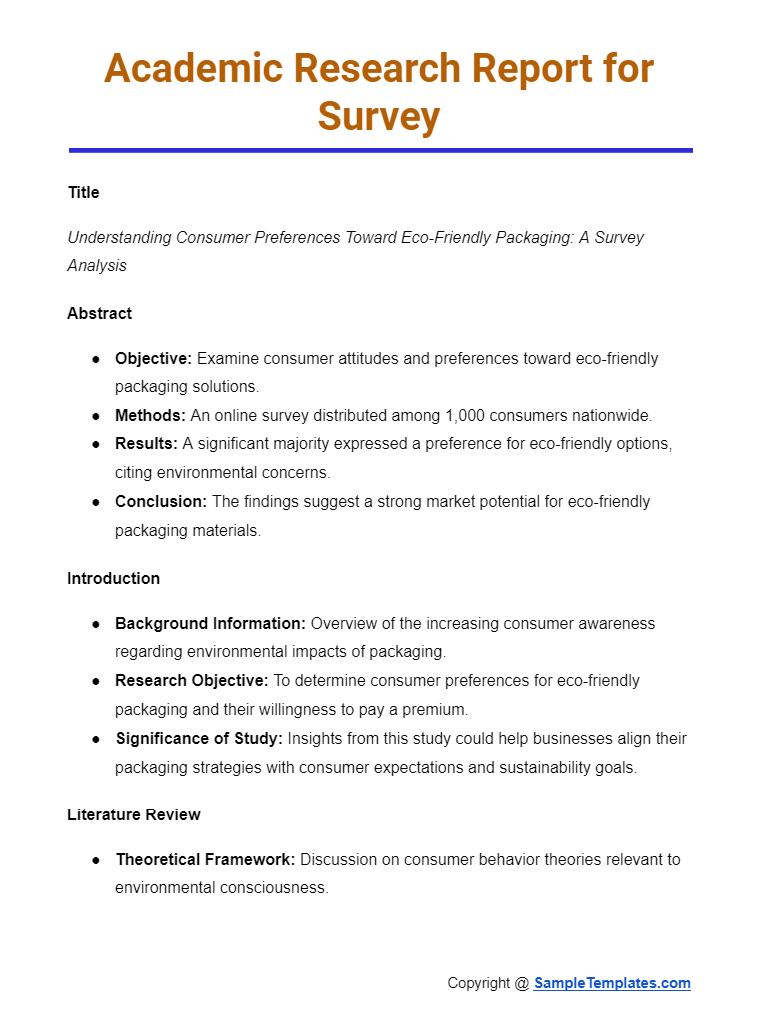
Educational Research Report
Title
The Impact of Digital Tools on Learning Outcomes in Middle School Mathematics
Abstract
- Objective: To assess the effectiveness of digital learning tools in improving math scores among middle school students.
- Methods: A quasi-experimental design with pre-tests and post-tests across control and experimental groups.
- Results: Students using digital tools showed a statistically significant improvement in test scores compared to those who did not.
- Conclusion: Digital tools are beneficial in enhancing mathematical understanding at the middle school level.
Introduction
- Background Information: Overview of the integration of technology in education and its potential impacts.
- Research Objective: To evaluate how digital tools influence learning outcomes in middle school math classes.
- Significance of Study: The findings can help educators make informed decisions about incorporating technology in teaching plans.
Literature Review
- Theoretical Framework: Key theories supporting the use of digital tools in education, such as the Technology Acceptance Model (TAM).
- Review of Related Literature: Summary of past research on technology in education, focusing on quantitative outcomes.
- Research Gap: Identification of areas that have not been thoroughly explored in previous studies, setting the stage for the current research.
Methods
- Study Design: Explanation of the quasi-experimental setup with details on the control and experimental groups.
- Participants: Demographic and academic background of the students involved in the study.
- Intervention: Description of the digital tools used, including software specifics and implementation strategies.
- Data Collection Methods: Outline of how data was collected, including the use of standardized tests and classroom observation.
- Data Analysis Techniques: Statistical methods employed to analyze the data, such as ANOVA or regression analysis.
Results
- Presentation of Data: Visuals like charts and graphs to illustrate key findings.
- Statistical Analysis Results: Detailed results of the statistical tests performed, highlighting significant differences.
- Comparative Analysis: Comparison between the control and experimental groups’ performance.
Discussion
- Interpretation of Findings: In-depth discussion on what the results signify about the use of digital tools in education.
- Implications for Practice: How educators can use these findings to enhance teaching strategies.
- Limitations: Acknowledgement of the limitations in study design or implementation that might have affected the results.
- Recommendations for Future Research: Suggestions for further studies to address unanswered questions or new issues that arose.
Conclusion
- Summary of Key Findings: Recap of the main insights from the research and their educational implications.
- Final Thoughts: Reflect on the broader impact of digital tools in educational settings.
References
- Citations: Detailed list of all academic references used throughout the research, formatted according to a specified academic style (e.g., APA).
Appendices
- Additional Materials: Copies of data collection instruments, consent forms, detailed data tables, and any other supplementary information that supports the research but is too detailed for the main body of the report.
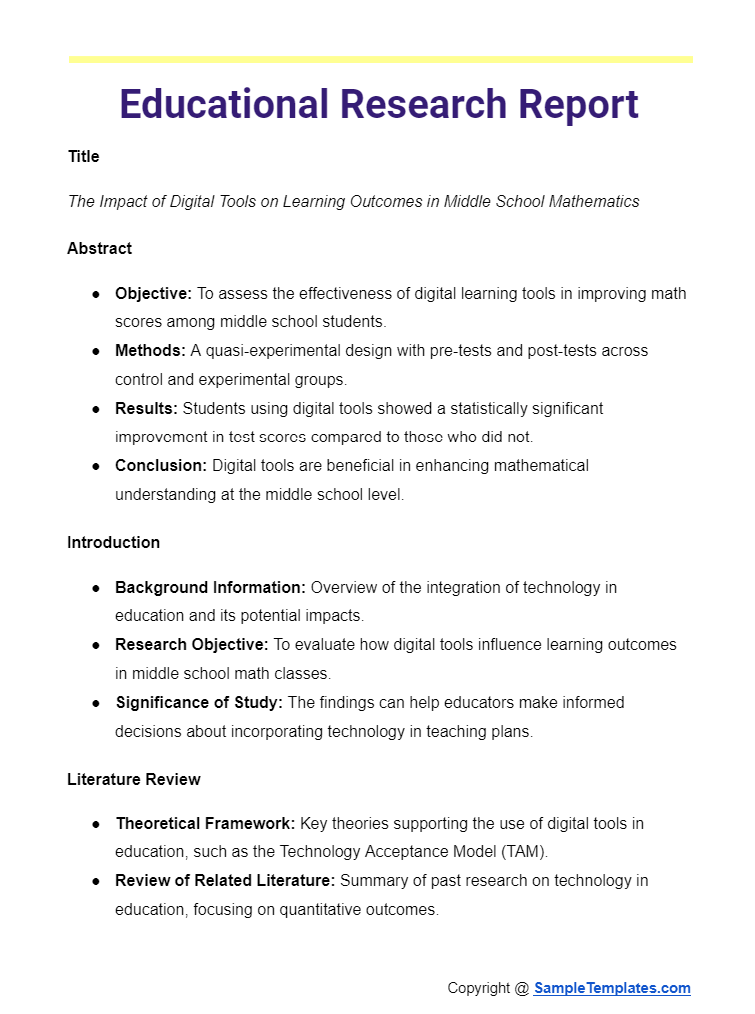
Browse More Templates On Academic Research Report
1. Academic Research Report Template
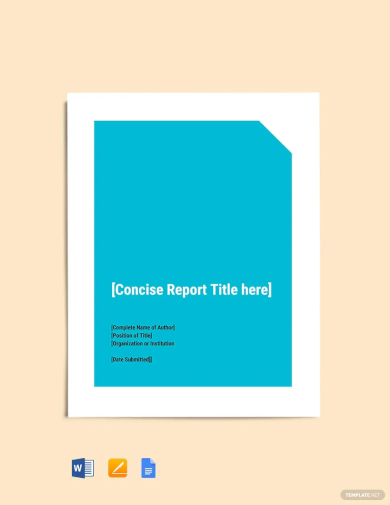
2. Basic Academic Research Report Template
3. Academic Research Report Example
4. Sample Genre Research Academic Report Template
5. Formal Academic Research Report Template
Tips For Preparing a Academic Research Report
- Understand the guidelines: Follow the specific format and requirements provided by your institution or journal. You can also see more on Research Project Reports.
- Organize your research: Structure your report with clear sections like introduction, methodology, results, discussion, and conclusion.
- Be concise and clear: Use clear, straightforward language and avoid unnecessary jargon or overly complex sentences.
- Cite your sources: Ensure all references and citations follow the required citation style (APA, MLA, etc.).
- Use visual aids: Incorporate charts, graphs, or tables where appropriate to support your findings.
- Proofread and edit: Review the report for grammatical errors, clarity, and flow, ensuring it’s free from mistakes. You can also see more on Student Research Report.
- Stay objective: Present your research findings without personal bias or unsupported opinions.
- Follow ethical guidelines: Ensure your research and reporting comply with academic integrity and ethical standards.
6. Research Degree Academic Referee Report Template
7. Academic Research Report Summary Template
8. Sample Academic Library Research Report Template
9. Printable Academic Report Template
Uses of Academic Research Report
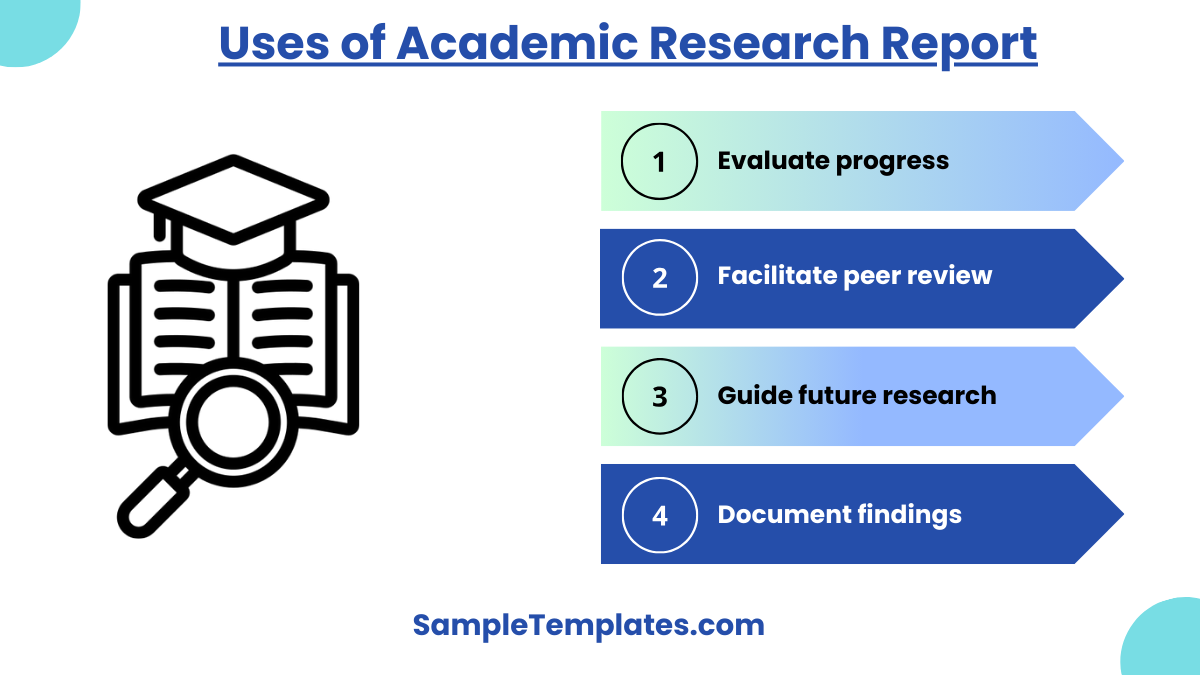
- Contribute to knowledge: Adds new insights, theories, or data to the existing body of research in a particular field. You can also see more on Report Format.
- Support decision-making: Provides evidence-based information to guide policies, practices, or interventions.
- Evaluate progress: Assesses the outcomes of a research project, measuring its success or impact.
- Facilitate peer review: Allows other experts to evaluate the research for accuracy, validity, and relevance.
- Guide future research: Identifies gaps in knowledge, suggesting areas for further study or exploration.
- Assist academic assessment: Used by educators and institutions to evaluate student or researcher performance. You can also see more on Scientific Research Report.
- Document findings: Serves as a formal record of research processes, methods, and outcomes.
- Enhance professional credibility: Demonstrates expertise and contributes to a researcher’s academic reputation or career advancement.
10. Sample Qualitative Research Report Template
11. Academic Undergraduate Research Report Format
12. Research Project Report Template
What Is an Academic Research Report?
If there is one thing you’ll need in writing academic research reports, that is strictly following the guidelines. Academic research reports tell us what we need to know about surveys, experiments, and other research methods. Discussed in the sample report is the analysis and description of actions that the researcher did to research the topic they are presenting. Academic research reports use a specific layout and include a certain set of sections. Writing an acceptable academic research report requires the researcher to follow formal academic writing guidelines strictly. Other guidelines include correct grammar, punctuation, spelling, and proper citing of trustworthy research sources.
An academic research report commonly includes a specific set of sections. These sections are the introduction, literature review, methods, results, discussion, and conclusion. These sections must appear in this order form in the report to establish uniformity with other academic research reports. After conducting an experiment or survey, the researcher starts to write the research report. The purpose of writing this report is to let interested individuals know the result of the whole study. You can also see more on Academic Research Plan.
How to Make an Academic Research Report
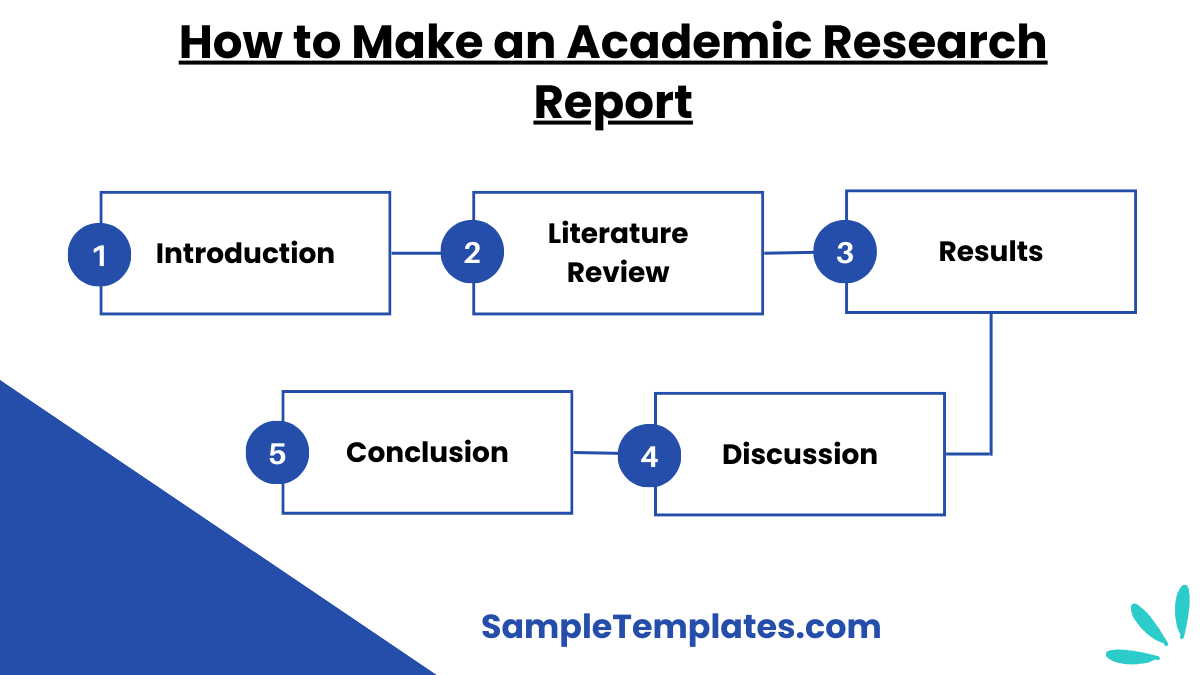
An academic research report is also called the end result of an academic research activity because it is created after the research activity is completed. To write an academic research report, you’ll need to know exactly what to put in the different sections, aside from following the report writing format guidelines.
1. Introduction
The research problem or the research topic is presented in this part of the report. The introduction is basically where you write an overview of the entire academic research, such as an overview of the findings, method, and outline of the report outline structure.
2. Literature Review
Write the background information of your research topic, which includes a summary of the work and findings of other researchers on the same topic. The background needed in the literature review is information about the topic that readers must know before proceeding to the following sections. Remember to write more about your work and not the work of other researchers.
3. Methodology
This is where you describe the methods or the steps used in conducting the research. Describe your steps in the past tense and, as much as possible, make your description detailed. Examples of methods used in gathering data for research are the process of survey sampling and conducting a scientific experiment.
4. Results
The results section is obviously where you can find the outcome of the research. It is best to use charts, graphs, or tables to present data for the results. It is still okay to write the findings in text. If you use tables and figures, make sure to highlight the important details in writing. What to write in this section include statistical analysis results, medical test results, sample survey participant’s answers, etc.
5. Discussion
Write here your interpretation of the report and the answers to the research questions listed in the introduction. Other details to include are the sample size of your survey participants, research limitations, missing data analysis, etc.
6. Conclusion
You should remember not to introduce new materials in this section. Use this section to write a summary of your work and provide sample recommendations that are based on your research findings.
FAQ’s
What makes a good academic research report?
A good academic report is one that uses the formal writing guidelines and uses resources that are acknowledged by one’s department. It also must include all the necessary sections and relevant content plan. The report should also be one that is easy to read and presented in an organized manner. Of course, it should be free from bias and written errors
What is the difference between an academic report and an academic essay?
An academic research report provides a discussion on the methods used by the researcher and the findings of their research based on facts and acknowledged resources. The researcher in an academic essay writes about their thoughts and opinions about the research topic.
Knowledge is power. Learning something new through research paves the way for new innovations. With the help of these research report samples and templates, you’ll surely write a detailed and informative essay academic research report. Download one now!
Related Posts
FREE 8+ Sample Acknowledgment Report Templates in MS Word ...
FREE 34+ Sample Report Writing Format Templates in PDF
FREE 7+ Sample Project Proposal Reports in PDF MS Word
Industry Analysis Sample
FREE 8+ Investigation Summary Report Samples in PDF DOC
FREE Sample Survey Reports in PDF MS Word
FREE 36+ Sample White Paper Templates in PDF
FREE 9+ Sample Need Assessment Templates in MS Word PDF
FREE 10+ Sample Psychological Reports in PDF MS Word | Pages
FREE 8+ Table of Content Templates in MS Word
FREE 7+ Sample Research Project Templates in PDF MS Word
FREE 5+ Paper Outline Samples in PDF MS Word
How to Research Your Cause for Writing the Petition?
FREE 8+ Essay Outline Samples in PDF MS Word
FREE 9+ Sample Science Project Reports in MS Word PDF
